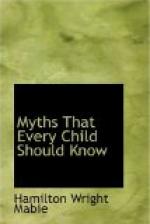Our idea of the world is scientific because it is based on exact though by no means complete knowledge; the myth-makers’ idea of the world was poetic because, with very incomplete knowledge, they could not imagine how anything could be done unless it was done as they did things. When the black clouds gather on a summer afternoon and roll up the sky in great, terrifying masses, and the lightning flashes from them and the crash of the thunder fills the air and the rain beats down the crops, we feel as if we were in the laboratory of nature seeing a wonderful experiment made; when our ancestors saw the same spectacle they were sure that a great dragon, breathing fire and roaring with anger, was ravaging the earth. As children to-day imagine that dolls are alive, that fairies dance in moonlit meadows on summer nights, or beasts or Indians make the sounds in the woods, so the people who made the myths filled the world with creatures unlike themselves, but with something of human intelligence, feeling and will.
As imaginative children personify the sounds they hear, so the men and women of an early time personified everything that lived or moved or gave any sign of life. They filled the earth, air, and sea with imaginary beings who had power over the elements and affected the lives of men. There were nymphs in the sea, dryads in the trees, kindly or destructive spirits in the air, household gods who watched over the home, and greater gods who managed the affairs of the world. When an intelligent man finds himself in new surroundings, he begins at once to study them and try to understand them. In every age this has been one of the greatest objects of interest to men, and every generation has endeavoured to explain the world, so as to satisfy not only its curiosity but its reason. The myths were explanations of the world created by people who had not had time to study that world closely nor to train themselves to study it in a scientific way. They saw the world with their imaginations quite as much as with their eyes, and as they put persons behind every kind and form of life, they told stories about the world instead of making accurate and matter-of-fact reports of it. The change of the seasons is not at all mysterious to us; but to the Norsemen it was a wonderful struggle between gods and giants. In the summer the gods had their triumph, but in the winter the giants had their way. Year after year and century after century this terrible warfare went on until a day should come when, in a last great battle, both gods and giants would be destroyed and a new heaven and earth arise. These same brave and warlike men believed that the most powerful fighter among the gods was Thor, and that it was the swinging and crashing of his terrible hammer which made the lightning and thunder.




